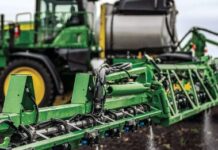CROP PROGRESS AND CONDITION
WEEK ENDING AUGUST 23, 2020
AGRICULTURAL SUMMARY: Conditions continued to deteriorate due to extreme heat and worsening drought, according to the Mountain Region Field Office of the National Agricultural Statistics Service, USDA. Northeastern counties received isolated moisture last week, but was not enough to improve local conditions. A county report indicated producers were noting more failure of non-irrigated crops due to drought including millet, corn, and sorghum. Heavy culling of cattle due to limited native grass availability was noted along with calves sold earlier than usual. Producers were providing supplemental feed to livestock where alternative grazing arrangements were unavailable. Concerns remained regarding irrigation water supplies holding out for the remainder of the growing season. In east central counties, spotty precipitation was received last week, but most areas remained hot and very dry. Corn silage harvest continued. A county report noted non-irrigated corn was being cut and baled instead of left for grain since few ears were produced this year. Southwestern counties received little moisture last week and multiple wildfires continued to burn. Severe drought conditions continued to persist in the district. In the San Luis Valley, barley harvest progressed quickly amidst dry conditions. Livestock were being moved from mountain pasture and stock water supplies were notably short. Limited potato harvest began for a few producers last week, but most were still killing potato vines. Conditions remained very dry. In southeastern counties, limited moisture was received but county reports noted more was needed to sustain crops and native pasture. Irrigation water supplies continued to lessen. Statewide, stored feed supplies were rated 7 percent very short, 31 percent short, 59 percent adequate, and 3 percent surplus. Sheep death loss was 70 percent average and 30 percent light. Cattle death loss was 85 percent average and 15 percent light.
CROP AND LIVESTOCK PROGRESS
| Commodity | Current week | Previous week | Previous year | 5-year average |
| (percent) | (percent) | (percent) | (percent) | |
| Alfalfa hay
3rd cutting harvested …………………………………… |
42 |
24 |
39 |
44 |
| Barley
Harvested …………………………………………………. |
61 |
22 |
36 |
44 |
| Corn
Doughed …………………………………………………… |
70 |
55 |
50 |
62 |
| Dented ……………………………………………………… | 23 | 12 | 8 | 19 |
| Harvested for silage …………………………………… | 6 | 2 | 8 | 6 |
| Dry edible beans
Blooming …………………………………………………. |
98 |
93 |
93 |
NA |
| Cut ………………………………………………………….. | 1 | — | — | 5 |
| Onions
Harvested …………………………………………………. |
4 |
2 |
— |
10 |
| Potatoes inside San Luis Valley
Harvested …………………………………………………. |
3 |
1 |
NA |
NA |
| Potatoes outside San Luis Valley
Harvested …………………………………………………. |
5 |
— |
8 |
12 |
| Sorghum
Headed …………………………………………………….. |
86 |
76 |
87 |
87 |
| Turning color ……………………………………………. | 16 | 5 | 6 | 23 |
NA – not available
(–) – zero
DAYS SUITABLE FOR FIELDWORK AND SOIL MOISTURE CONDITION
| Current week | Previous week | Previous year | 5-year average | |
| Days suitable for fieldwork ………………………………
|
6.9
|
7.0
|
6.4
|
6.5
|
| Topsoil moisture | (percent) | (percent) | (percent) | (percent) |
| Very short ………………………………………………… | 39 | 38 | 5 | 5 |
| Short ……………………………………………………….. | 44 | 42 | 17 | 21 |
| Adequate …………………………………………………. | 17 | 20 | 74 | 71 |
| Surplus…………………………………………………….. | — | — | 4 | 3 |
| Subsoil moisture
Very short ………………………………………………… |
43 |
43 |
2 |
6 |
| Short ……………………………………………………….. | 42 | 36 | 18 | 21 |
| Adequate …………………………………………………. | 15 | 21 | 77 | 71 |
| Surplus…………………………………………………….. | — | — | 3 | 2 |
NA – not available
(–) – zero
NASS provides accurate, timely, and useful statistics in service to U.S. agriculture. We invite you to provide occasional feedback on our products and services. Sign up at http:/usda.mannlib.cornell.edu/subscriptions and look for “NASS Data User Community.” USDA is an equal opportunity provider, employer and lender. To file a complaint of discrimination, write: USDA, Director, Office of Civil Rights, 1400 Independence Ave., S.W., Washington, D.C. 20250-9410 or call (800) 795-3272 (voice), or (202) 720-6382 (TDD).
CROP, LIVESTOCK, PASTURE AND RANGE CONDITION
| Commodity | Current week | Previous week | Previous year | 5-year average |
| (percent) | (percent) | (percent) | (percent) | |
| Alfalfa hay
Very poor …………………………………………………. |
10 |
7 |
4 |
3 |
| Poor …………………………………………………………. | 18 | 14 | 5 | 8 |
| Fair ………………………………………………………….. | 20 | 22 | 10 | 21 |
| Good ……………………………………………………….. | 45 | 48 | 60 | 55 |
| Excellent ………………………………………………….. | 7 | 9 | 21 | 13 |
| Barley
Very poor …………………………………………………. |
1 |
— |
2 |
NA |
| Poor …………………………………………………………. | 3 | 1 | 5 | NA |
| Fair ………………………………………………………….. | 19 | 22 | 23 | NA |
| Good ……………………………………………………….. | 52 | 58 | 50 | NA |
| Excellent ………………………………………………….. | 25 | 19 | 20 | NA |
| Corn
Very poor …………………………………………………. |
19 |
14 |
— |
1 |
| Poor …………………………………………………………. | 18 | 14 | 2 | 5 |
| Fair ………………………………………………………….. | 24 | 26 | 14 | 19 |
| Good ……………………………………………………….. | 32 | 36 | 59 | 61 |
| Excellent ………………………………………………….. | 7 | 10 | 25 | 14 |
| Dry edible beans
Very poor …………………………………………………. |
3 |
3 |
1 |
2 |
| Poor …………………………………………………………. | 22 | 19 | 3 | 6 |
| Fair ………………………………………………………….. | 41 | 41 | 29 | 27 |
| Good ……………………………………………………….. | 33 | 37 | 58 | 58 |
| Excellent ………………………………………………….. | 1 | — | 9 | 7 |
| Onions
Very poor …………………………………………………. |
3 |
2 |
— |
2 |
| Poor …………………………………………………………. | 6 | 6 | — | 5 |
| Fair ………………………………………………………….. | 24 | 28 | 4 | 16 |
| Good ……………………………………………………….. | 62 | 59 | 95 | 68 |
| Excellent ………………………………………………….. | 5 | 5 | 1 | 9 |
| Pasture and range
Very poor …………………………………………………. |
22 |
27 |
2 |
6 |
| Poor …………………………………………………………. | 42 | 28 | 4 | 11 |
| Fair ………………………………………………………….. | 27 | 31 | 20 | 23 |
| Good ……………………………………………………….. | 8 | 13 | 64 | 51 |
| Excellent ………………………………………………….. | 1 | 1 | 10 | 9 |
| Potatoes inside San Luis Valley
Very poor …………………………………………………. |
2 |
2 |
— |
— |
| Poor …………………………………………………………. | 5 | 5 | 3 | 3 |
| Fair ………………………………………………………….. | 17 | 13 | 30 | 16 |
| Good ……………………………………………………….. | 53 | 55 | 47 | 59 |
| Excellent ………………………………………………….. | 23 | 25 | 20 | 22 |
| Potatoes outside San Luis Valley
Very poor …………………………………………………. |
2 |
2 |
— |
— |
| Poor …………………………………………………………. | 7 | 7 | 2 | 1 |
| Fair ………………………………………………………….. | 23 | 23 | 17 | 10 |
| Good ……………………………………………………….. | 56 | 56 | 67 | 76 |
| Excellent ………………………………………………….. | 12 | 12 | 14 | 13 |
| Sorghum
Very poor …………………………………………………. |
16 |
17 |
1 |
2 |
| Poor …………………………………………………………. | 26 | 21 | 3 | 7 |
| Fair ………………………………………………………….. | 45 | 39 | 24 | 24 |
| Good ……………………………………………………….. | 9 | 20 | 59 | 60 |
| Excellent ………………………………………………….. | 4 | 3 | 13 | 7 |
| Sugarbeets
Very poor …………………………………………………. |
5 |
1 |
— |
— |
| Poor …………………………………………………………. | 9 | 4 | 1 | 2 |
| Fair ………………………………………………………….. | 24 | 22 | 11 | 14 |
| Good ……………………………………………………….. | 52 | 60 | 82 | 71 |
| Excellent ………………………………………………….. | 10 | 13 | 6 | 13 |
| Sunflowers
Very poor …………………………………………………. |
7 |
7 |
— |
— |
| Poor …………………………………………………………. | 28 | 24 | — | 3 |
| Fair ………………………………………………………….. | 46 | 47 | 20 | 24 |
| Good ……………………………………………………….. | 19 | 21 | 66 | 63 |
| Excellent …………………………………………………..
|
— | 1
|
14
|
10
|
| Livestock
Very poor …………………………………………………. |
3 |
3 |
— |
— |
| Poor …………………………………………………………. | 8 | 7 | 3 | 2 |
| Fair ………………………………………………………….. | 35 | 33 | 5 | 12 |
| Good ……………………………………………………….. | 46 | 50 | 78 | 75 |
| Excellent ………………………………………………….. | 8 | 7 | 14 | 11 |
NA – not available
(–) – zero
Contact: Bill Meyer
(800) 392-3202
August 24, 2020




